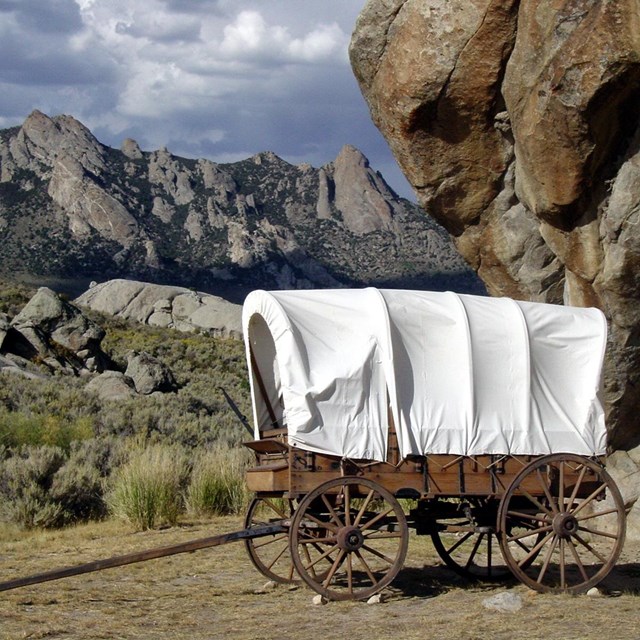Part of a series of articles titled Death Came A-Knockin’: Freak Accidents on the Westering Trails.
Article
Death-Winds in the Sierra Nevada

Image/Wikimedia Commons
Hurricane-force winds struck parts of the western US in September 2020, knocking down huge trees and tearing shingles from roofs. Emigrants traveling west in covered wagons encountered severe windstorms, too--some with deadly outcomes.
Twenty-two-year-old Oliver Goldsmith, traveling with a company of forty-niners from Detroit, described one such storm and its fatal results. In the thickly forested Sierra Nevada between the Pit and Feather rivers in California, his company “encountered a terrible wind storm one night; the crashing of the big pine trees, as they fell, echoing and re-echoing through the gorges, sounded like deafening thunder, and made the earth fairly shake.” Traveling on afterward, Goldsmith recalled many years later,
...We saw a woman on her knees weeping and praying; three young children were with her, each having on its back a pack as large as it could comfortably carry. The packs were made of shirts, the lower part tied into a bag shape with a string, the sleeves securing the burden to the little bearer’s body.…She told us that on the evening of the dreadful storm, a night or two before we saw her, while she and her children were asleep in the wagon, the husband and son—resting outside and guarding them and the cattle—were both crushed under a large tree that fell just beyond the wagon. They were instantly killed, but if they had not been, she and the little ones could never have released them. Some emigrants coming along had removed and buried the bodies. The mother then prepared the children to continue the journey, giving them as many provisions as they could carry, and was praying for protection and guidance when we discovered them.
The little family was forced to continue on foot, packing their belongings, because the storm also killed several of the cattle that drew their covered wagon.
Another storm in the same area – or perhaps the same one described by Goldsmith—raged the night of October 30, 1849, in an emigrant camp at Deer Creek, along the Lassen Trail in California. Forty-niner J. Goldsborough Bruff, a forty-five-year-old Argonaut from Washington DC, was living in a long-term camp near the trail, guarding his company’s belongings while the other men went ahead for supplies. Passing emigrants often camped near Bruff, as they did on this night. Sleeping in his tent as the winds howled outside, he and a companion named Willis “were awakened by a man, crying at the top of his voice,--'Hallo, here! Turn out and assist, a tree has fallen on a couple of tents, and killed and wounded several persons!’” About 100 yards from Bruff’s tent, a large oak tree had fallen across two emigrant tents.
Four men of the Ormond Alford family lay in the first tent. The tree’s “long heavy trunk” had to be rolled off the crushed tent with levers, “consequently mutilating the lower extremities of the unfortunate wretches beneath it.” Within the tent “lay a shocking sight!” Bruff continues:
An aged, grey headed man, and his grown son, with their hips buried in the ground, and their ghastly eyes turned up in death! Next another son, and beside him, a young man, his comrade, slowly dying in agony, with broken legs and mutilated bodies.—groaning and uttering the name of God, in acute suffering! The screaming of the females, the grey-headed mother kissing their pallid brows while her silver hairs swept their faces, and then she would groan & scream.—and her 2 grown daughters stood, with clasped hands, choking sobs, and eyes upraised to Heaven, regardless of the bleak storm and rain.
The second injured son and his friend died the next day. Two little girls in the second tent suffered less serious injuries.
Amid sleet and snow over the following two days, Bruff and other men dug a grave in the hard, frozen earth for the four dead men. At the widow’s request, Bruff climbed down into the grave to pull the covering from the men’s faces so that the survivors could say a last goodbye:
Their eyes were wide open; and [the widow] was very vehement in her grief; -- crying out, with clasped hands, ‘Why did he take them all at once?—and not leave me one!”
Using a board from a wagon, Bruff “scratched and painted together” a grave marker inscribed with the names of three of the victims: Ormond Alford, 54; William M. Alford, 19; and Lorenzo D Alford, 15. The family friend who also died was not named. The grieving family continued along the trail the day after the funeral, having also lost a cow and a pony to thieves that prowled the area.
[Quotations are from Oliver Goldsmith, Overland in Forty-Nine: The Recollections of a Wolverine Ranger after a Lapse of Forty-seven Years, 1896, p. 77; and J. Goldsborough Bruff, Gold Rush: The Journals, Drawings, and Other Papers of J. Goldsborough Bruff, 1944, Vol. 1, pp 251-255.]
Last updated: January 26, 2021


